Why Asian currencies will keep going up
Asia's recovery has been nothing short of spectacular. But fast growth creates its own problems, and governments will have to raise interest rates. While that means lean times ahead for Asian stocks, Asian currencies are set to keep on rising, says Cris Sholto Heaton.

Asia is pulling away from the developed world. Over the past year, growth in emerging Asia has rebounded at double-digit rates, at a time when most developed economies remain sluggish, even with huge, expensive jolts of government spending.
But fast growth creates its own problems. Sure, these are problems that most Western central banks would be happy to have. But Asia can't afford to take its eye off the ball. Inflation is now starting to pick up across the region.
Central banks will need to act soon to stop their economies from over-heating. Rates will be rising almost everywhere in the next few months. That promises to be helpful for Asian currencies, but more of a problem for stocks
MoneyWeek
Subscribe to MoneyWeek today and get your first six magazine issues absolutely FREE

Sign up to Money Morning
Don't miss the latest investment and personal finances news, market analysis, plus money-saving tips with our free twice-daily newsletter
Don't miss the latest investment and personal finances news, market analysis, plus money-saving tips with our free twice-daily newsletter
The recovery can't sustain this pace
Asia's recovery has been spectacular. During the crisis, I wrote that I expected emerging Asia to make a solid comeback once the freefall in exports had ended. Solid domestic consumption and generally low debt levels almost guaranteed that.
More MoneyWeek Asia articlesWhy you should avoid Chinese banksThailand's woes aren't overMoneyWeek Asia archive
But the speed and scale of the rebound has surprised me as much as anyone else. As the chart below shows, Asian industrial production is now well above the previous peak, while the US languishes well below.
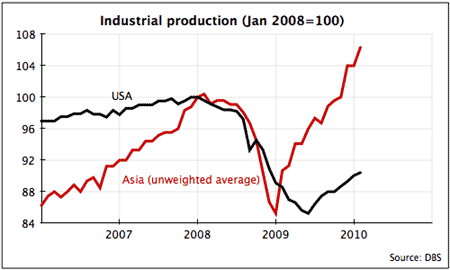
This can't go on forever. A V-shaped recovery like this is only possible when there is substantial spare capacity in the economy which in this case was opened up by the global collapse in late 2008. With that gone, excessively strong demand will rapidly lead to inflation. We're now at the point where central banks will have to raise rates and tighten monetary policy significantly.
Inflation is picking up across Asia
Some are already starting to do this, but there's a long way to go. Last week, India raised interest rates for the second time in a month. Yet inflation is now running at 9.9% a year. There are some question marks about how representative Indian inflation data is. The reality may not be as severe as that. But even the Reserve Bank of India admits it is behind the curve and will be raising rates several more times in the months ahead.
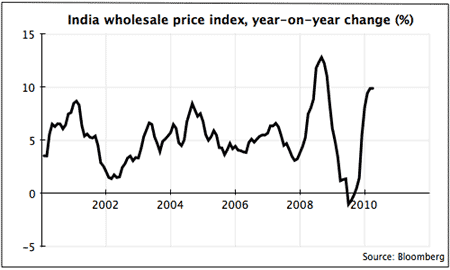
Things are a little different in China. Consumer price inflation is rising. But it doesn't yet look threatening at 2.4%. That reflects the relatively high level of overcapacity in many Chinese industries, compared to the rest of Asia.
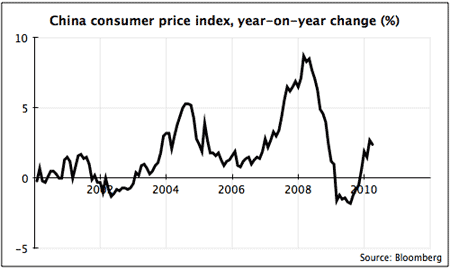
But the authorities are right to be worried about asset prices. House prices are clearly bubbly in some key cities. And this could spread further. So they're trying to tighten policy in a targeted way.
New restrictions have just been announced on minimum deposits and mortgages for second and subsequent homes. We've already seen the regulator raise the amount of reserves that banks need to hold against loans and we'll probably see rate hikes in the coming months. But in China, these are less relevant than the instructions given to banks on how much they can lend, and to who.
These moves generally seen as tougher than expected bear watching. Construction is a very important part of GDP and the recovery. So the government certainly doesn't want to stub activity out altogether, as it did by clamping down very hard at the end of 2007 (see chart below).
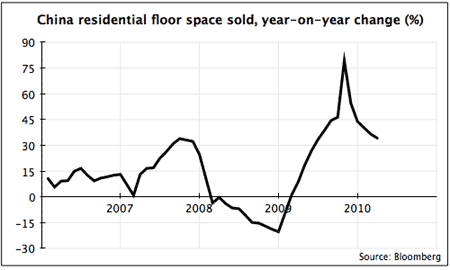
In fact, it wants the supply of lower-end property to grow to meet demand from rural workers moving to cities in the years ahead.
But it also wants to avoid the developed world's mistake of allowing a leveraged real estate bubble to develop among middle-class buyers. So we can expect more tightening in the months ahead, including a trial property tax in key cities, to make the costs of speculation higher.
Elsewhere, inflation is not out of control. But it is rising, and central banks will have to respond soon. Malaysia raised rates for the first time at the start of March, earlier than expected. Meanwhile, Singapore is allowing its currency to rise again - as a small, trade-dependent economy, Singapore adjusts monetary policy by changing its target exchange rate rather than setting interest rates. Most of the rest of emerging Asia is likely to follow in the next six months.
Higher rates will push currencies higher
This will create a big gulf between monetary conditions in Asia and most of the developed world. In the latter, rates are likely to stay low for a long time. I'd be surprised if the US Federal Reserve tightens until well into next year at the earliest.
Expert tips & advice for investing in Asia! Claim your FREE guides from MoneyWeek that include:
- How to go about investing to Asia
- Which brokers to use to buy foreign shares
This widening rate gap will put further pressure on Asian currencies to rise against those of the developed world. Most major Asian currencies are well up from their lows during the worst of the crisis, as the chart below shows.
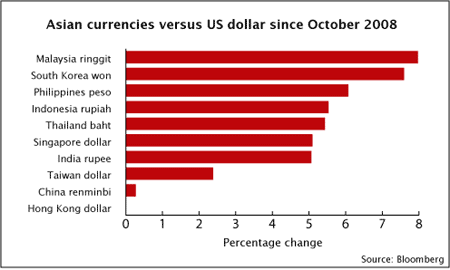
All but the won, the rupee and the peso are also higher versus the dollar than they were before markets peaked in late 2007. But most are still undervalued - most Asian countries have held down their currencies for many years to promote exports.
And a wider interest rate gap versus the developed world will be just one factor drawing more foreign capital into Asian currencies. China will play a key part here. After allowing the renminbi to rise 20% against the dollar between mid-2005 and mid-2008, it has held its currency in place since then. It seems likely that it will resume rising sometime in the second half of the year.
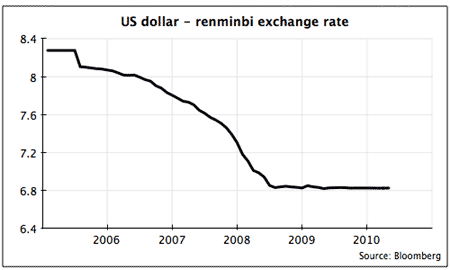
Many other Asian countries are reluctant to allow their currencies to rise too much while the renminbi remains pegged, as this will make their exporters less competitive. But once the renminbi resumes its upward trend, the rest of Asia is likely to follow. The Hong Kong dollar is the exception. It is officially fixed at HK$7.8/USD. This system has been in place since 1983 and is highly unlikely to change in the foreseeable future.
Expect slower progress in stocks
While bullish for currencies, higher rates don't help the stock market. They make competing investments (such as rates on bank deposits and short-term government and corporate debt) more attractive. And as the economy begins to slow, the spectacular growth in corporate profits that we see coming out of the recession also drops off, removing another tailwind for stocks.
The same is likely to happen this time. After last year's surge, markets are highly unlikely to deliver similar returns again. The next couple of years could well be a slow trudge higher, interspersed with sell-offs as the world works through its problems. We've already seen a 10% fall and rally this year during the Greek rollercoaster. I'm surprised it hasn't been worse.

Valuations won't help much. The MSCI Asia ex Japan is neither cheap nor expensive, currently standing at 499 on a price/book value ratio of 1.99. That's in line with the average over the last 40 years for which we have data.
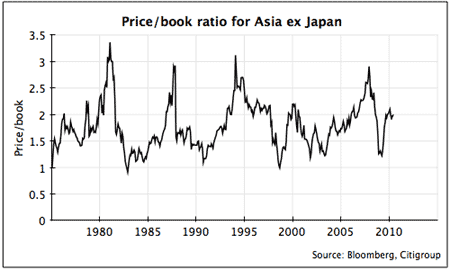
That suggests we can expect average long-term returns. Historically, the average return on equity (ROE) for the MSCI Asia ex Japan has been about 11-12%. Since ROE measures the profits generated by firms' net assets and price/book measures how much we are paying for those assets relative to their carrying value in corporate accounts, dividing ROE by price/book gives us an indication of what our long-term returns might be from here. (For more on what ROE and price/book are and how they work, see my earlier piece here.)
In this case, if ROE is 12% and p/b is 1.99 this gives us an expected return of 6%. That's an expected real return (ie after inflation), since companies should be able to pass on the effects of inflation over time. As the chart below shows, that's an average-to-good return by the standards of most equity markets in the 20th century.

Foreign investors in Asia should also get a sizeable boost from the steady rise of Asian currencies against their home currencies. And I believe that investors will be able to do significantly better by targeting a few key sectors, as I discussed here. Incidentally, a couple of readers have asked about dedicated Asian consumer funds. The short answer is there aren't any that I know of, but I'll be looking at specific ways to invest in these themes in a future issue.
Still, while the prospect of a 6% long-term real return from the broad market is very reasonable, it isn't shouting 'value' from the rooftops either. That suggests there's little to attract huge amounts of new money into Asian markets for now. So once we combine this with the headwind of rising interest rates, a couple of muted years seem likely.
This article is from MoneyWeek Asia, a FREE weekly email of investment ideas and news every Monday from MoneyWeek magazine, covering the world's fastest-developing and most exciting region. Sign up to MoneyWeek Asia here
Get the latest financial news, insights and expert analysis from our award-winning MoneyWeek team, to help you understand what really matters when it comes to your finances.
Cris Sholto Heaton is an investment analyst and writer who has been contributing to MoneyWeek since 2006 and was managing editor of the magazine between 2016 and 2018. He is especially interested in international investing, believing many investors still focus too much on their home markets and that it pays to take advantage of all the opportunities the world offers. He often writes about Asian equities, international income and global asset allocation.
Cris began his career in financial services consultancy at PwC and Lane Clark & Peacock, before an abrupt change of direction into oil, gas and energy at Petroleum Economist and Platts and subsequently into investment research and writing. In addition to his articles for MoneyWeek, he also works with a number of asset managers, consultancies and financial information providers.
He holds the Chartered Financial Analyst designation and the Investment Management Certificate, as well as degrees in finance and mathematics. He has also studied acting, film-making and photography, and strongly suspects that an awareness of what makes a compelling story is just as important for understanding markets as any amount of qualifications.
-
 ‘Why I have ditched my Help to Buy ISA for cash savings and the stock market’
‘Why I have ditched my Help to Buy ISA for cash savings and the stock market’Without the 25% bonus, my Help to Buy ISA is effectively redundant, says MoneyWeek writer Sam Walker.
-
 Is your inheritance tax allowance cut if you sell to downsize or sell your home to pay for care?
Is your inheritance tax allowance cut if you sell to downsize or sell your home to pay for care?Downsizing relief is a little-known benefit that could save your loved ones tens of thousands of pounds in inheritance tax after you’ve died.
